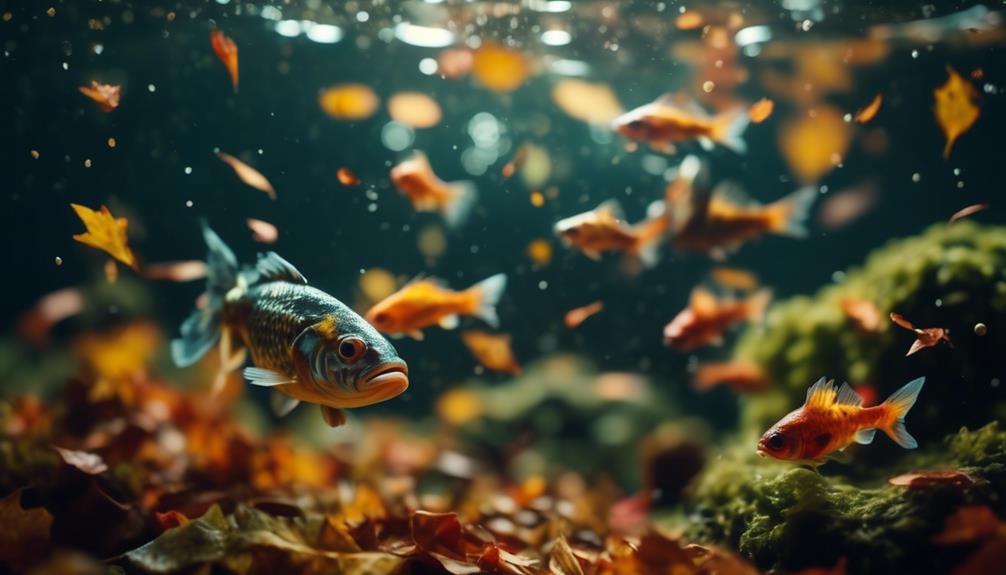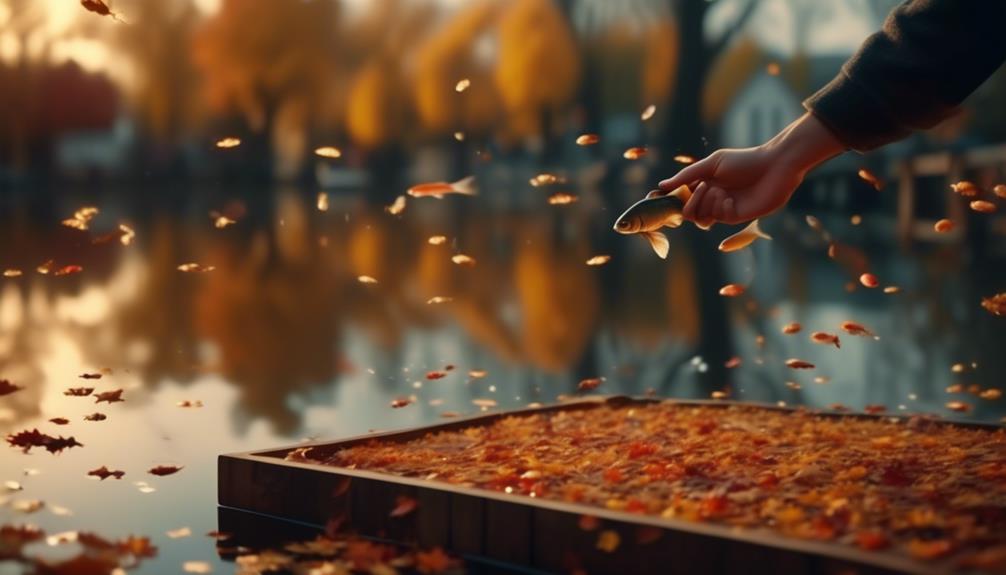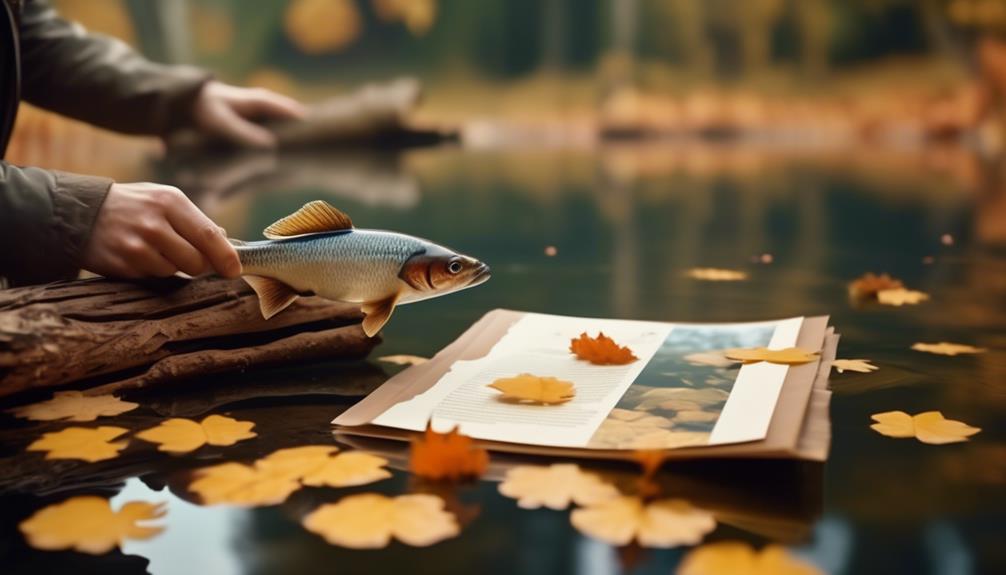When the leaves change color and it gets chilly, it's time for pond owners to feed their fish the right food to keep them healthy in winter. Fish like koi and goldfish need different food in cold water because their bodies slow down. It's important to give them food that's easy to digest at this time to help them get through the winter and be strong for spring.
A good choice is Aquascape Premium Cold Water Fish Food, which is made for this purpose. But, you have to be careful about when and how you feed your fish, so you don't upset the balance of your pond.
Here are some tips:
- Start feeding cold water food when the temperature drops below 50 degrees Fahrenheit.
- Feed less than usual because fish eat less when it's cold.
- Make sure the food you use is high-quality and made for cold weather.
- Stop feeding when the water gets too cold, usually around 39 degrees Fahrenheit, because the fish won't be able to digest it.
By following these steps, you'll help your fish stay healthy all year.
Key Takeaways
Proper nutrition for pond fish in the fall is key to their health over the winter. Feeding them a special diet like Aquascape Premium Cold Water Fish Food is important because it's easier for the fish to digest in chilly water, giving them the energy they need to stay strong.
This is essential because, during winter, fish enter a dormant state where they eat less. If they've been fed well in the fall, they'll be better equipped to handle the cold and have a strong start in the spring.
For example, as temperatures drop, a fish's metabolism slows down. The Aquascape food is designed to match their slower digestion, which helps prevent any stomach problems that could come from eating food meant for warmer water.
By paying attention to this detail, you're setting your fish up for a healthy season ahead. It's like giving them a winter coat that fits just right – it keeps them warm and ready to jump back into action when the ice melts and the water warms up again.
The Critical Fall Feeding Period
As the weather gets colder in the fall, it's very important to feed pond fish the right kind of food to keep them healthy. When the water in the pond gets cooler than 60 degrees, the fish's bodies don't work as quickly, and they can't digest food as well. They need food that's easier for them to break down, like feeds with wheat germ and spirulina. These ingredients are good because fish can digest them even when the water is cold.
It's smart to keep track of the pond's temperature with a thermometer. This way, you can make sure you're feeding the fish at the best times based on how warm or cold the water is. Giving fish the right food before winter helps them stay strong during the cold months and bounce back quickly when spring comes. To do this well, you need to know when to change what you're feeding them.
For example, as the temperature starts to fall, gradually switch the fish's diet to a high-quality wheat germ-based pellet. These pellets are not only easier for fish to digest, but they're also packed with the nutrition the fish need to prepare for winter. Keeping an eye on the temperature and adjusting your feeding schedule is a simple yet effective way to care for your pond fish.
It's like putting on a warm coat in winter; it's a small step that makes a big difference for their health.
Understanding Fish Metabolism
Fish metabolism is the set of life-sustaining chemical reactions that enables fish to use food for energy and normal body functions. This process becomes particularly important when the seasons change to fall and the water gets colder. As the temperature of the water falls, fish don't need as much food because their bodies slow down, making them digest food at a slower pace.
Here's what you need to know about fish metabolism:
- The speed at which fish burn energy is greatly affected by the temperature of the water they live in.
- When their metabolism slows down in cooler water, they don't need to eat as much.
- Feeding fish too much when it's cold can cause health problems for them.
- Feeding fish the right amount in the fall helps them store energy for the winter.
Why is this important? Understanding fish metabolism means you can feed your fish the right amount and type of food. This helps keep your fish healthy as the weather changes.
Let's make this simpler:
Think of fish like little engines that run slower when it's cold. In the fall, you don't want to give them more gas (food) than they can burn. When you feed them just enough, they stay in good shape and have enough energy stored up to make it through the winter. If you're not sure what to feed them, ask an expert at a local pet store or look for food that's made for cooler water temperatures. Always check the instructions to avoid overfeeding.
Following these tips will help your fish stay active and healthy, even when they're wearing their 'winter coats' in the chilly water.
Benefits of Cold Water Nutrition

It's important to know how to keep pond fish healthy when it's cold. When the water gets colder than 60 degrees, fish don't need as much food because they aren't as active. Aquascape Premium Cold Water Fish Food is made for goldfish and koi when it's cold. It has spirulina and wheat germ, which are easy for fish to digest. This means the fish get all the good stuff they need from their food. Keep feeding them this food until it's warmer than 60 degrees regularly. This helps them get through winter and be strong for spring.
Here's why this matters: In the fall, taking care of your fish by feeding them the right food helps them survive the cold. When they wake up in spring, they'll be healthy and full of energy. Remember, a little bit of care in the fall makes a big difference for your fish later.
Choosing the Right Fall Diet
When it's fall and the weather cools, pond fish need a special diet. This helps them stay healthy and build up energy for winter, as they don't eat much when it's cold. The right fall food is easy for fish to digest and has the perfect mix of nutrients.
Here's what to look for in fall fish food:
- Pick food with lots of wheat germ. It's easy for fish to break down.
- Choose food that's not too high in protein. Fish are less active in the cold, so they don't need as much.
- Get food with extra vitamins and minerals to help fish fight off sickness.
- Go for food that floats. It keeps the pond clean by reducing leftovers at the bottom.
For example, you might get a floating wheat germ pellet that's lower in protein and enriched with vitamins A and E. This way, your pond fish get all they need to prepare for winter without making a mess in their home.
Preparing for Winter Slumber

As the weather gets colder, it's important to feed your pond fish the right kind of food to help them get ready for winter. When the pond water gets colder than 60 degrees, the fish's bodies don't work as fast, and they can't digest food as well. To help them during this time, you should give them a special food like Aquascape Premium Cold Water Fish Food. This food is made to be easy for the fish to digest when it's cold and has healthy ingredients like spirulina and wheat germ to keep them well during the winter. Keep feeding them this food until the water is warmer than 60 degrees consistently.
Doing this helps your fish stay strong and healthy, so when spring comes, they are ready to be active again.
Here are the key reasons why this is important:
- Fish need the right nutrition to handle the cold and stay healthy all winter long.
- The special food you give them is made for cold water and has everything they need to stay in good shape.
- It's also easy for them to digest, which is super important when their bodies slow down in the cold.
- By taking care of them in the winter, you're also making sure they're in good health for spring.
Spring Health Starts in Fall
Feeding your pond fish well in the fall is key to their health in the spring. As it gets colder, fish need the right food to store energy for winter. If you feed them the right diet now, they'll be healthy and strong when it warms up again.
- Switch to a Carb-Heavy Diet: Give your fish foods that are rich in carbs to help them build up their energy stores.
- Keep an Eye on the Temperature: When the pond water gets cooler than 50°F, switch to special food made for cold water.
- Feed Them Less Often: Fish don't need to eat as much when it's cold because their bodies slow down. Feeding them less keeps the pond cleaner.
- Pick the Best Food: Choose high-quality food that fish can easily digest during the cold months.
Feeding fish like this in the fall helps them keep a strong immune system. This means they're better at fighting off sickness when it gets warm in the spring.
For example, you might want to try brands known for their cold-water fish food, like TetraPond Spring & Fall Diet. This kind of food helps because it's made for the cooler weather and gives the fish what they need.
Related Educational Resources

For those who own ponds and want to keep them healthy, there are easy-to-follow resources available. These include guides and articles written by experts on how to take care of fish and maintain ponds. The resources are designed to help you understand how to feed fish depending on the season and how to keep your pond in good shape.
Below is a list of some key materials:
- A guide titled 'Preparing Your Pond for Winter' gives you straightforward steps to get your pond ready for colder weather.
- An article called 'Feeding Koi Right' provides detailed information on what koi fish need to eat all year round.
- A video 'Simple Feeding Techniques for Pond Fish' shows you the best ways to feed your pond fish.
These resources are meant to help your pond flourish. They explain not just how to do something but why it's important, such as why feeding fish the right food matters for their health and your pond's ecosystem. For example, the winterizing guide might suggest using a pond heater and recommend specific brands known for their reliability.
The goal is to make it easier for you to create a beautiful and healthy pond environment.
Contact and Additional Support
Aquascape is committed to helping pond owners take good care of their fish, especially when the weather gets cold. Here's how we help:
- We have easy-to-follow guides and feeding times for your fish.
- You can talk to our experts if you have questions.
- Our blog has lots of helpful articles and tips.
- Sign up for our E-Newsletter to get the latest news and advice.
All these tools are designed to give you and your pond life the best care during autumn and winter.
For example, we'll recommend the right kind of food for your fish for when it's cold, and show you how to keep your pond clean and healthy.
Frequently Asked Questions
How Do I Adjust Feeding Quantities for Fish in the Fall Compared to Summer Feeding Routines?
When the water starts getting cooler, feeding your fish less is key because their bodies don't need as much food. This happens when the water is colder than 60 degrees Fahrenheit. They slow down and don't use as much energy, so they don't need to eat as much. It's like how you're not as hungry after a lazy day compared to after a busy one. To help them out, give them food made especially for cold water. This type of food is easier for them to digest when it's cold and keeps them healthy. It's kind of like how we might eat a hearty soup in winter instead of a summer salad. Remember, a healthy fish is a happy fish, and adjusting their diet for the fall is a smart way to take care of them.
Are There Any Specific Times of Day That Are Best for Feeding Fish in the Fall?
In the fall, it's best to feed your fish when it's warmest, usually around the middle of the day. This is because fish have more energy and can digest their food better when it's warmer. As it gets colder in the evening, their bodies slow down. Make sure you don't give them too much food; just enough to keep them healthy. It's like how you might enjoy a good lunch to keep you going until dinner. Just like you wouldn't want to eat a big meal right before bedtime, fish benefit from eating when they can best use the energy from their food.
Can I Introduce New Fish to My Pond in the Fall, and How Will Fall Feeding Affect Them?
Adding new fish to your pond during autumn can work, but you need to be careful to get them used to their new environment slowly. Making sure they eat right is also key for their health as the weather gets colder.
Here's why this matters: When temperatures drop, fish's metabolism slows down, which changes how they digest food. You'll need to feed them less and switch to a food that's easier for them to digest at cooler temperatures. For example, use wheat germ-based fish food, which is specifically designed for cold weather feeding.
Remember, introduce your new fish gradually. Float them in the pond in their bag so they can adjust to the water temperature. This helps prevent shock. Keep an eye on them to make sure they're settling in well.
Should I Change the Type of Food I Give My Fish if My Pond Has a Heater and Maintains a Consistent Temperature Through the Fall?
When you have a pond heater that keeps the water temperature steady, you might not need to switch the food you're giving your fish. But it's still important to keep an eye on how the fish are doing. You want to make sure they're active and healthy. If they seem off, it might be time to think about changing their diet.
For example, if you notice your fish are less energetic than usual, they might need a food that's easier to digest. In warmer water, fish usually have faster metabolisms and can handle high-protein diets. But if the temperature is consistent and not too warm, a food that's not as rich could be better.
Remember, the type of food matters. If you've been feeding your fish a summer diet high in protein, and the water temperature is consistently warm even in the fall, they might be fine continuing on that diet. On the other hand, if the water is only just warm enough to keep them comfortable, a milder, wheat-germ-based food might be more suitable. Wheat germ is easier for fish to digest when their metabolism slows down in cooler water.
Keep talking to your local fish store or do some research for product recommendations that suit your specific pond conditions. And always check for signs that your fish are happy and healthy.
How Does the Presence of Aquatic Plants in the Pond Impact Fall Feeding Practices for Fish?
Water plants are important in a pond because they give fish places to hide and extra food to eat. This means that when it gets cold in the fall, fish might not need as much food from us because they can get more from their environment. We have to think about this when we decide how much and what kind of food to give them. For example, if there's a lot of natural food like plants and insects, we might feed them less fish food. It's like when we eat a big salad; we might not want a big meal afterward. We should choose the right kind of food too, like wheat germ-based pellets that are easier for fish to digest when the water is cool. It's important to watch the fish and see how they act and eat, so we can keep them healthy when the seasons change.
Conclusion
Feeding pond fish properly in autumn is crucial to keep them healthy during winter's rest. A diet made for cooler water, like Aquascape Premium Cold Water Fish Food, helps with better digestion and energy use as the water cools.
By doing this, fish stay strong in winter and are set up to thrive when warmer weather returns in spring.

